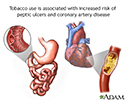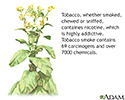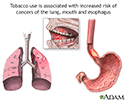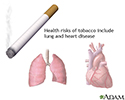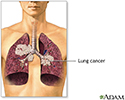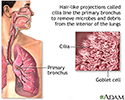Risks of tobacco
Secondhand smoke - risks; Cigarette smoking - risks; Smoking and smokeless tobacco - risks; Nicotine - risks
Information
Tobacco is a plant. Its leaves are smoked, chewed, or sniffed for a variety of effects.
- Tobacco contains the chemical nicotine, which is an addictive substance.
- Tobacco smoke contains more than 7000 chemicals, 69 of which are known to cause cancer.
- Tobacco that is not burned is called smokeless tobacco. Including nicotine, there are 29 chemicals in smokeless tobacco that are known to cause cancer.
HEALTH RISKS OF SMOKING OR USING SMOKELESS TOBACCO
Knowing the serious health risks of using tobacco may help motivate you to quit. Using tobacco over a long time can increase your risk of many health problems.
Heart and blood vessel problems:
-
Blood clots
and
weakness in the walls of blood vessels
in the brain, which can lead to
stroke
Blood clots
Blood clots are clumps that occur when blood hardens from a liquid to a solid. A blood clot that forms inside one of your veins or arteries is calle...
 ImageRead Article Now Book Mark Article
ImageRead Article Now Book Mark ArticleWeakness in the walls of blood vessels
An aneurysm is a weak area in the wall of a blood vessel that causes the blood vessel to bulge or balloon out. When an aneurysm occurs in a blood ve...
 ImageRead Article Now Book Mark Article
ImageRead Article Now Book Mark ArticleStroke
A stroke occurs when blood flow to a part of the brain stops. A stroke is sometimes called a "brain attack. " If blood flow is cut off for longer th...
 ImageRead Article Now Book Mark Article
ImageRead Article Now Book Mark Article -
Blood clots in the legs
, which may travel to the lungs
Blood clots in the legs
Deep vein thrombosis (DVT) is a condition that occurs when a blood clot forms in a vein deep inside a part of the body. It mainly affects the large ...
 ImageRead Article Now Book Mark Article
ImageRead Article Now Book Mark Article -
Coronary artery disease
, including
angina
and heart attacks
Coronary artery disease
Coronary heart disease is a narrowing of the small blood vessels that supply blood and oxygen to the heart. Coronary heart disease (CHD) is also cal...
 ImageRead Article Now Book Mark Article
ImageRead Article Now Book Mark ArticleAngina
Angina is a type of chest discomfort or pain due to poor blood flow through the blood vessels (coronary vessels) of the heart muscle (myocardium). Th...
Read Article Now Book Mark Article -
Temporarily increased
blood pressure
after smoking
Blood pressure
Blood pressure is a measurement of the force exerted against the walls of your arteries as your heart pumps blood to your body. Hypertension is the ...
 ImageRead Article Now Book Mark Article
ImageRead Article Now Book Mark Article - Poor blood supply to the legs
-
Problems with erections
because of decreased blood flow into the penis
Problems with erections
An erection problem occurs when a man cannot get or keep an erection that is firm enough for intercourse. You may not be able to get an erection at ...
 ImageRead Article Now Book Mark Article
ImageRead Article Now Book Mark Article
Other health risks or problems:
- Cancer (more likely in the lung, mouth, larynx, nose and sinuses, throat, esophagus, stomach, bladder, kidney, pancreas, cervix, colon, and rectum)
- Poor wound healing after surgery
- Lung problems, such as COPD or asthma that is harder to control
-
Problems during pregnancy, such as babies born at a low birth weight,
early labor
, losing your baby, and
cleft lip
Early labor
A premature infant is a baby born before 37 completed weeks of gestation (more than 3 weeks before the due date).
Read Article Now Book Mark ArticleCleft lip
Cleft lip and palate are birth defects that affect the upper lip and the roof of the mouth.
 ImageRead Article Now Book Mark Article
ImageRead Article Now Book Mark Article - Decreased ability to taste and smell
- Harm to sperm, which may lead to infertility
-
Loss of sight due to an increased risk of
macular degeneration
Macular degeneration
Macular degeneration is an eye disorder that slowly destroys sharp, central vision. This makes it difficult to see fine details and read. The diseas...
 ImageRead Article Now Book Mark Article
ImageRead Article Now Book Mark Article - Tooth and gum diseases
- Wrinkling of the skin
Smokers who switch to smokeless tobacco instead of quitting tobacco still have health risks:
- Increased risk of mouth or nasal cancer
-
Gum problems, tooth wear, and
cavities
Cavities
Dental cavities are holes (or structural damage) in the teeth.
 ImageRead Article Now Book Mark Article
ImageRead Article Now Book Mark Article - Worsening high blood pressure and angina
HEALTH RISKS OF SECONDHAND SMOKE
Those who are often around the smoke of others (secondhand smoke) have a higher risk of:
- Heart attack and heart disease
-
Lung cancer
Lung cancer
Small cell lung cancer (SCLC) is a fast-growing type of lung cancer. It spreads much more quickly than non-small cell lung cancer. There are two typ...
 ImageRead Article Now Book Mark Article
ImageRead Article Now Book Mark Article - Sudden and severe reactions, including of the eye, nose, throat, and lower respiratory tract
Infants and children who are often exposed to secondhand smoke are at risk of:
- Asthma flares (children with asthma who live with a smoker are much more likely to visit the emergency room)
- Infections of the mouth, throat, sinuses, ears, and lungs
- Lung damage (poor lung function)
-
Sudden infant death syndrome (
SIDS
)
SIDS
Sudden infant death syndrome (SIDS) is the unexpected, sudden death of a child under age 1. An autopsy does not show an explainable cause of death....
Read Article Now Book Mark Article
Like any addiction, quitting tobacco is difficult, especially if you are doing it alone.
- Seek support from family members, friends, and coworkers.
-
Talk to your health care provider about
nicotine replacement therapy
and
smoking cessation medicines
.
Nicotine replacement therapy
Nicotine replacement therapy is a treatment to help people stop smoking. It uses products that supply low doses of nicotine. These products do not ...
Read Article Now Book Mark ArticleSmoking cessation medicines
Your health care provider can prescribe medicines to help you quit tobacco use. These medicines do not contain nicotine. They work in a different w...
Read Article Now Book Mark Article -
Join a
smoking cessation program
and you will have a much better chance of success. Such programs are offered by hospitals, health departments, community centers, and work sites.
Smoking cessation program
It is hard to quit smoking if you are acting alone. Smokers may have a much better chance of quitting with a support program. Stop smoking programs...
Read Article Now Book Mark Article
References
Benowitz NL, Brunetta PG. Smoking hazards and cessation. In: Broaddus VC, Mason RJ, Ernst JD, et al, eds. Murray and Nadel's Textbook of Respiratory Medicine . 6th ed. Philadelphia, PA: Elsevier Saunders; 2016:chap 46.
Rakel RE, Houston T. Nicotine addiction. In: Rakel RE, Rakel DP, eds. Textbook of Family Medicine . 9th ed. Philadelphia, PA: Elsevier Saunders; 2016:chap 49.
Siu AL; U.S. Preventive Services Task Force. Behavioral and pharmacotherapy interventions for tobacco smoking cessation in adults, including pregnant women: U.S. Preventive Services Task Force Recommendation Statement. Ann Intern Med . 2015;163(8):622-634. PMID: 26389730 www.ncbi.nlm.nih.gov/pubmed/26389730 .
-
Tobacco and vascular disease - illustration
Tobacco use and exposure may cause an acceleration of coronary artery disease and peptic ulcer disease. It is also linked to reproductive disturbances, esophageal reflux, hypertension, fetal illness and death, and delayed wound healing.
Tobacco and vascular disease
illustration
-
Tobacco and chemicals - illustration
Some of the chemicals associated with tobacco smoke include ammonia, carbon dioxide, carbon monoxide, propane, methane, acetone, hydrogen cyanide and various carcinogens. Other chemicals that are associated with chewing or sniffing tobacco include aniline, naphthalene, phenol, pyrene, tar, and 2-naphthylamine.
Tobacco and chemicals
illustration
-
Tobacco and cancer - illustration
Tobacco and its various components increase the risk of several types of cancer especially cancer of the lung, mouth, larynx, esophagus, bladder, kidney, pancreas, and cervix. Smoking also increases the risk of heart attacks, strokes and chronic lung disease.
Tobacco and cancer
illustration
-
Tobacco health risks - illustration
In general, chronic exposure to nicotine may cause an acceleration of coronary artery disease, peptic ulcer disease, reproductive disturbances, esophageal reflux, elevated blood pressure, fetal illnesses and death, and delayed wound healing.
Tobacco health risks
illustration
-
Secondhand smoke and lung cancer - illustration
Secondhand smoke has been classified as a known cause of lung cancer in humans (Group A carcinogen).
Secondhand smoke and lung cancer
illustration
-
Respiratory cilia - illustration
The bronchus in the lungs are lined with hair-like projections called cilia that move microbes and debris up and out of the airways. Scattered throughout the cilia are goblet cells that secrete mucus which helps protect the lining of the bronchus and trap microorganisms.
Respiratory cilia
illustration
-
Tobacco and vascular disease - illustration
Tobacco use and exposure may cause an acceleration of coronary artery disease and peptic ulcer disease. It is also linked to reproductive disturbances, esophageal reflux, hypertension, fetal illness and death, and delayed wound healing.
Tobacco and vascular disease
illustration
-
Tobacco and chemicals - illustration
Some of the chemicals associated with tobacco smoke include ammonia, carbon dioxide, carbon monoxide, propane, methane, acetone, hydrogen cyanide and various carcinogens. Other chemicals that are associated with chewing or sniffing tobacco include aniline, naphthalene, phenol, pyrene, tar, and 2-naphthylamine.
Tobacco and chemicals
illustration
-
Tobacco and cancer - illustration
Tobacco and its various components increase the risk of several types of cancer especially cancer of the lung, mouth, larynx, esophagus, bladder, kidney, pancreas, and cervix. Smoking also increases the risk of heart attacks, strokes and chronic lung disease.
Tobacco and cancer
illustration
-
Tobacco health risks - illustration
In general, chronic exposure to nicotine may cause an acceleration of coronary artery disease, peptic ulcer disease, reproductive disturbances, esophageal reflux, elevated blood pressure, fetal illnesses and death, and delayed wound healing.
Tobacco health risks
illustration
-
Secondhand smoke and lung cancer - illustration
Secondhand smoke has been classified as a known cause of lung cancer in humans (Group A carcinogen).
Secondhand smoke and lung cancer
illustration
-
Respiratory cilia - illustration
The bronchus in the lungs are lined with hair-like projections called cilia that move microbes and debris up and out of the airways. Scattered throughout the cilia are goblet cells that secrete mucus which helps protect the lining of the bronchus and trap microorganisms.
Respiratory cilia
illustration
Review Date: 8/29/2015
Reviewed By: Laura J. Martin, MD, MPH, ABIM Board Certified in Internal Medicine and Hospice and Palliative Medicine, Atlanta, GA. Internal review and update on 09/01/2016 by David Zieve, MD, MHA, Isla Ogilvie, PhD, and the A.D.A.M. Editorial team.

